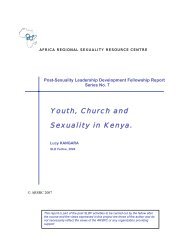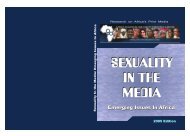body images beauty culture and language - Africa Regional ...
body images beauty culture and language - Africa Regional ...
body images beauty culture and language - Africa Regional ...
Create successful ePaper yourself
Turn your PDF publications into a flip-book with our unique Google optimized e-Paper software.
culturally learned, individual appreciation of <strong>beauty</strong> aesthetics or individual sexual<br />
preference is far more variegated <strong>and</strong> context-driven than racial <strong>and</strong> cultural stereotypes<br />
suggest.<br />
This episode also replicates a thous<strong>and</strong> others in the <strong>culture</strong> <strong>and</strong> literature, which<br />
forcefully draws our attention to the difference between what we may call ‘social <strong>body</strong>’<br />
<strong>and</strong> ‘sexual <strong>body</strong>.’ Sexual <strong>body</strong> is <strong>body</strong> of any dimensions, sex, colour, state or structure<br />
(including mentally <strong>and</strong> physically challenged states <strong>and</strong> structures) that is capable of<br />
experiencing <strong>and</strong> or provoking sexual desire <strong>and</strong> also capable of providing mutual or<br />
non-mutual sexual realization or fulfillment in a given situation. Social <strong>body</strong> on the other<br />
h<strong>and</strong> is the <strong>body</strong> image that is socially projected through various structures of society as<br />
the ideals of <strong>beauty</strong> <strong>and</strong> sensuality irrespective of individual capabilities, <strong>and</strong> individual<br />
aesthetic or sexual preferences. Within this configuration, <strong>body</strong> image can be seen as a<br />
power construct, that is, society through its indoctrination processes projects <strong>body</strong> <strong>images</strong><br />
that are often at variance with individual <strong>body</strong> statuses, aesthetic tastes, sexual conditions<br />
<strong>and</strong> sexual preferences. Where <strong>body</strong> is universal, <strong>body</strong> image is racial, social or cultural<br />
<strong>and</strong> hegemonic; it is imposing <strong>and</strong> imposed.<br />
The examples of <strong>body</strong> <strong>and</strong> <strong>beauty</strong> inscription in Yoruba <strong>Africa</strong>n <strong>language</strong> <strong>and</strong> aesthetics<br />
given in the foregoing can be analyzed to counter a number of widely held but incorrect<br />
views about traditional <strong>Africa</strong>n perception of <strong>body</strong>, <strong>beauty</strong> <strong>and</strong> sexuality. First <strong>and</strong> most<br />
important is the idea that the traditional <strong>Africa</strong>n cultural image of the plump woman as<br />
model <strong>beauty</strong> implies a correlation of female <strong>beauty</strong> with procreation functions in<br />
traditional <strong>Africa</strong>n consciousness. This view is often expressed in terms of the “closer to<br />
nature, ‘primitive’ aspects of other [non-western] societies” (Weeks et al 2003: 5).<br />
However, contrary to such views, the expressions isolated in Yoruba <strong>language</strong> about<br />
complexion, <strong>body</strong> <strong>and</strong> <strong>body</strong> parts, signify autonomous aesthetic valuation. Roundness<br />
itself is perceived as an autonomous aesthetic model of female <strong>beauty</strong> which can be<br />
appreciated even in non-conjugal relationships as shown by expressions such as Bí ọmọ<br />
eni bá dára ka wi, ti pe a o fi se aya kọÏ (“if our daughter is a <strong>beauty</strong> we should<br />
acknowledge it [because it is true], not that we would make a wife of her”). The apparent






